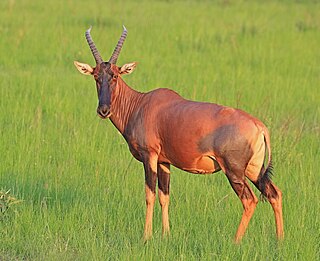
Phaseolus is a genus of herbaceous to woody annual and perennial vines in the family Fabaceae containing about 70 plant species, all native to the Americas, primarily Mesoamerica.

Lima bean also commonly known as the butter bean, sieva bean, double bean, Madagascar bean, chad bean, or wax bean is a legume grown for its edible seeds or beans.

The subfamily Alcelaphinae of the family Bovidae contains wildebeest, hartebeest, bonteboks, and several similar species. Depending on the classification, there are 6-10 species placed in four genera, although Beatragus is sometimes considered a subgenus of Damaliscus, and Sigmoceros for the Lichtenstein's hartebeest.

The topi, sassaby, tiang or tsessebe is a large African antelope of the genus Damaliscus and subfamily Alcelaphinae in the family Bovidae, with a number of recognised geographic subspecies. Some authorities have split the different populations of the species into different species, although this is seen as controversial.

Aradidae bear the appropriate common name, flat bugs, in reference to their (usually) extremely flattened body. With few exceptions, these often cryptic insects are of no economic importance. Common temperate genera include Aradus, Mezira, Neuroctenus, and Aneurus.

The spectacled tern, also known as the grey-backed tern, is a seabird in the family Laridae.

Lotaustralin is a cyanogenic glucoside found in small amounts in Fabaceae austral trefoil, cassava, lima bean, roseroot and white clover, among other plants. Lotaustralin is the glucoside of methyl ethyl ketone cyanohydrin and is structurally related to linamarin, the acetone cyanohydrin glucoside also found in these plants. Both lotaustralin and linamarin may be hydrolyzed by the enzyme linamarase to form glucose and a precursor to the toxic compound hydrogen cyanide.

Cochliobolus lunatus is a fungal plant pathogen that can cause disease in humans and other animals. The anamorph of this fungus is known as Curvularia lunata, while Cochliobolus lunatus denotes the teleomorph or sexual state. They are, however, the same biological entity. Cochliobolus lunatus is the most commonly reported species in clinical cases of reported Cochliobolus infection.

The silver-breasted broadbill is a species of bird in the broadbill family, Eurylaimidae. It is monotypic within the genus Serilophus. There are ten currently recognised subspecies, one of which, rubropygius, was formerly treated as a separate species.
The moon-toothed degu is a species of rodent in the family Octodontidae. It is endemic to Chile, occurring in mountainous areas along the Pacific coast in the central part of the country.

Damaliscus lunatus jimela is a subspecies of topi, and is usually just called a topi. It is a highly social and fast type of antelope found in the savannas, semi-deserts, and floodplains of sub-Saharan Africa.

The plate fish is a flounder in the genus Bothus, found in the warmer parts of the Atlantic including the Caribbean. Its typical habitat is sandy plains near coral reefs and it is able to change its colouring to make it well-camouflaged in this environment. It is sometimes known as the peacock flounder, a name also given to the closely related Bothus mancus from the Indo-Pacific.

Isopogon ceratophyllus, commonly known as the horny cone-bush or wild Irishman, is a plant of the family Proteaceae that is endemic to the coast in Victoria, South Australia and on the Furneaux Group of islands in Tasmania. It is a small woody shrub that grows to 100 cm high with prickly foliage. It is extremely sensitive to dieback from the pathogen Phytophthora cinnamomi
The tsetsebe, sassaby or Bangweulu tsessebe is a population and possible taxon of topi or sassaby, which are large African antelopes of grasslands. This population is presently restricted to northern Zambia in the wild, although it was recorded as occurring in neighbouring southernmost Democratic Republic of the Congo in the 1940s. Also seen as the northernmost population belonging to the nominate southern sassaby subspecies, in 2003 it was described as a new species, only to be downgraded to a subspecies a few years later. Its taxonomic status is unclear as of 2021. As an individual sassaby of this taxon cannot be clearly distinguished from populations to the south, the taxon was defined using an experimental suite of statistical techniques applied to a sample set, based on multivariate analysis, and recognised under an experimental new taxonomy. Nominate sassaby antelopes become progressively darker on average in the northern populations, and on average have a slightly thicker horns at the base of the skull, but those of northern Zambia are the darkest and with the most robust horns on average.

Ceratophyllus gallinae, known as the hen flea in Europe or the European chicken flea elsewhere, is an ectoparasite of birds. This flea was first described by the German botanist and entomologist Franz von Paula Schrank in 1803.

Ceratophyllus is a widespread genus of fleas found in temperate climates. Some of its members include the chicken flea, Ceratophyllus gallinae, and the poultry flea, Ceratophyllus niger.

Ceratophyllus columbae is a species of flea in the family Ceratophyllidae. It was described by Gervais in 1844.
Ceratophyllus phrillinae is a species of flea in the family Ceratophyllidae. It was described by Smit in 1976.

Triepeolus lunatus, commonly known as the lunate longhorn cuckoo bee, is a species of cuckoo bee in the family Apidae. It is found in North America from Canada to northern Mexico. Triepeolus lunatus tends to live in forest edges and meadows.
Lusterala is a monotypic, neotropical genus of tortix moths provisionally assigned to tribe Grapholitini of subfamily Olethreutinae, with Lusterala phaseolana as sole species. Genus and species were both described in 2007 by John Wesley Brown and Kenji Nishida. The holotype is conserved at the National Museum of Natural History in Washington, DC.














